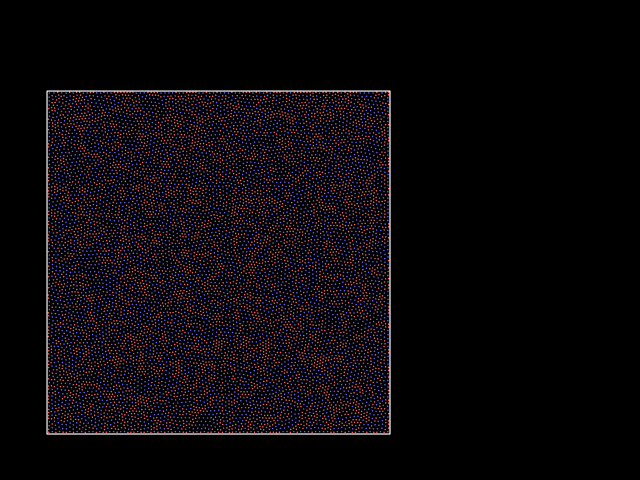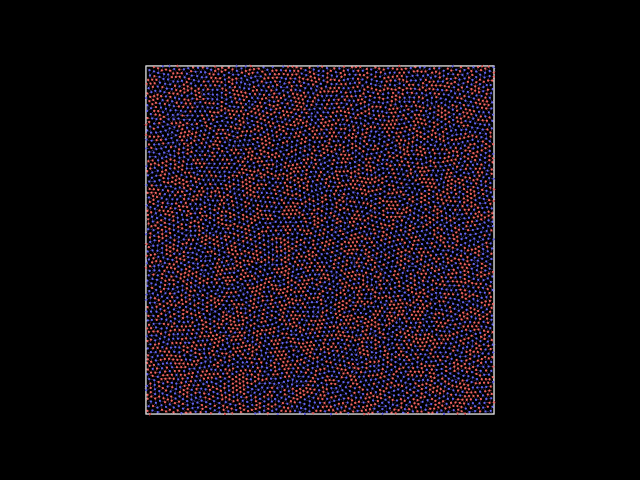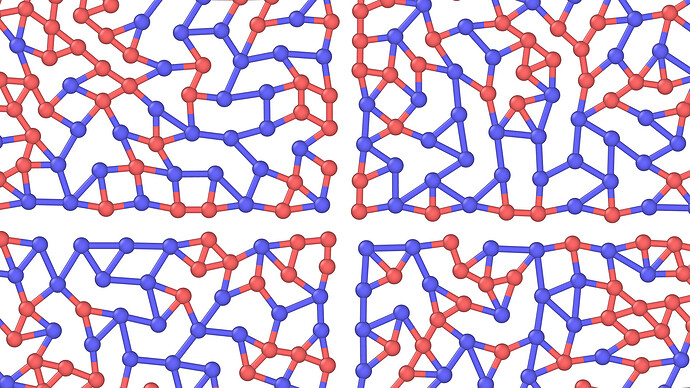Dear all,
I am trying to apply simple shear to an elastic network also known as a random fibre network.
I want to apply simple shear and minimize the system with cg minimizer.
However, when I looked at the configuration of the system, I found the box is deformed, but the network is shrunk as is shown in the attached gif.
LAMMPS version: LAMMPS (2 Aug 2023 - Update 3)
Interaction: Only bonded interaction
Bond type: harmonic/restrain
Minimalistic code:
boundary p p p
.
.
variable L0 equal $(lx)
variable deltaxy equal 0.4
variable delta equal ${deltaxy}*${L0}
....
bond_style harmonic/restrain
bond_coeff 1 0.5
run 0
change_box all triclinic
change_box all xy delta ${delta} remap boundary p p p units box
fix 1 all enforce2d
fix 2 all brownian 1.0e-22 252111 rng none gamma_t 1
min_style cg
min_modify dmax 1e-1 line backtrack #norm max #quadratic #backtrack #forcezero
minimize 0.0 1.0e-12 100000000 100000000
My question: Can anyone please tell me if am I correct in applying the boundary conditions? As far as I know, LAMMPS’s version of the Lees-Edward boundary condition, viz. box deformation is the same as the shifted reentry method.
Or if I am doing something fundamentally, wrong please correct me or do I need the shifted re-entry method to apply here?

Hi @Harish_Charan1,
It is nearly impossible to provide meaningful help as there is no information whatsoever in your input concerning your bonding topology.
Good rule of thumb would be that you look if your particles are connected according. The bonds should be explicit in a dedicated section of a data file you can write using the write_data command, and that you can visualize in OVITO or some other software of your liking. You can write the file before and after the minimization if needed.
As Germain said, more information is required. In particular, do you have bonds spanning periodic boundaries?
I suspect bond style harmonic/restrain may not work with box deformation.
@Germain Thank you for your reply.
Here I have attache the input file and the data file
in.simpleshear-min (3.7 KB)
STATE-Z3.5 (784.6 KB)
I see the bonds section is written well and LAMPPS is executing the it without an error.
However, if I deform my box nodes/particle should reenter from other suzed of the box so that the shape is maintained. Do you think the LAMMPS version of Lees-Edwards boundary conditions, which is deformed box, can be used to shear bonded networks?
Thanks for your reply @jtclemm I see that bonds are not crossing the boundaries as is also seen in the gif I attached.
None of your bonds are connecting beads through boundary conditions so that’s why your network collapses. See the attached picture which is a corner of your box with replication along x and y axis.
@Germain , I truly appreciate your assistance. Your solution works perfectly for me, allowing bonded interactions to simulate an infinite system [attached is the new bonded state file]. However, upon generating the network with cross-boundary nodes, I encountered contraction from the +/- y-walls, as illustrated in the attached gif. Additionally, at the end of the Brownian dynamics run, the system contracts to nearly half its size, leading to an unusual stress vs. time plot, attached pdf. Could you offer any suggestions regarding these issues? I’m uncertain if I’m utilizing the boundary conditions correctly. I would be very happy for any advice.

stress-time.pdf (12.7 KB)
STATE-Z3.5 (497.6 KB)
I would guess bond harmonic/restrain is unable to handle deforming periodic geometries. Looking at the source code, it operates by saving initial atom positions to calculate equilibrium lengths as needed. Across periodic boundaries, it uses the current box geometry to find the closest image which is no longer compatible with the initial atomic coordinates. One could additionally save the initial box geometry in the bond style to patch this issue, but @akohlmey should weigh in.
Another solution is bond style bpm/spring which can reproduce the behavior of harmonic/restrain except it saves equilibrium lengths to memory.
Thanks, @Germain, for your input. I’ve addressed the issue by connecting the edge beads across the box sides to mimic periodic boundary conditions, and now everything is functioning correctly. I’ve successfully replicated a published result. Additionally, as highlighted by @jtclemm, in the current version of LAMMPS (2 Aug 2023 - Update 3), the bond harmonic/restrain feature doesn’t work in a deformed box. To overcome this limitation, I’ve utilized the “bond harmonic” method and assigned bond coefficients, ‘k’ and ‘ro’ to each bond type (in my case this corresponds to, bond type = number of bonds) in the STATE file. This approach has provided the solution I needed, allowing me to replicate published findings and commence my own work.
Once again thank you so much, @Germain and @jtclemm.


